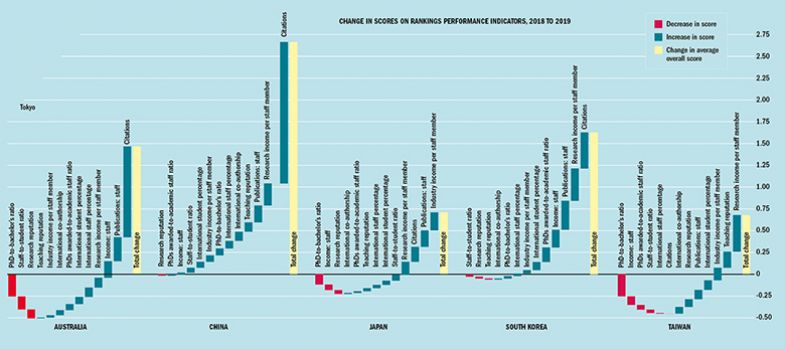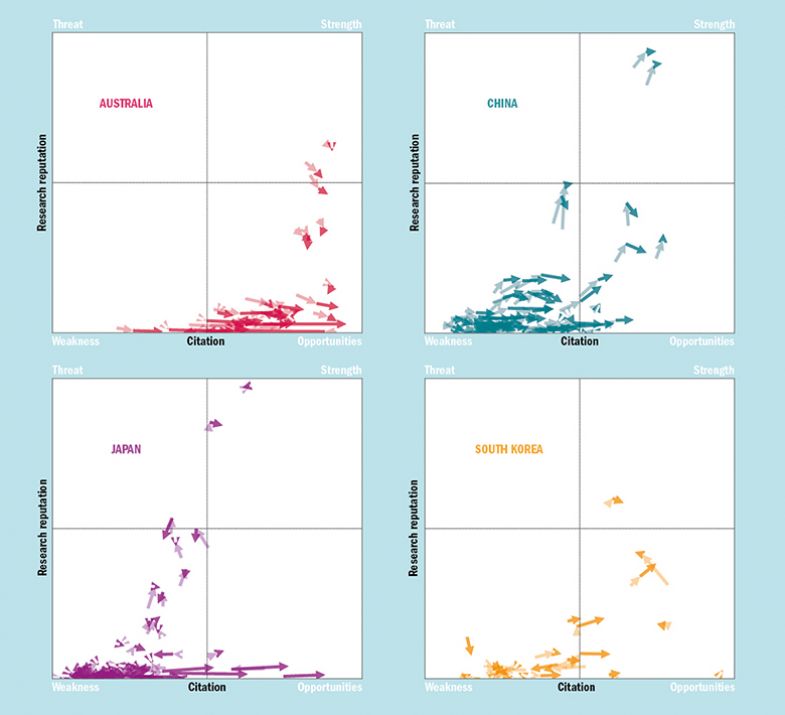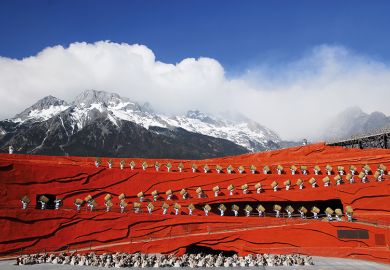Browse the full THE Asia-Pacific University Rankings 2019 results
The below “waterfall” charts show how the average ranking scores for universities have changed year-on-year in five of the major sectors in the Asia-Pacific area.
They reveal that although the average overall score in every region has risen, there is wide variation in the extent of the increase between the sectors and in terms of the metrics that have contributed to the change.
For instance, the average overall score for universities in China has gone up noticeably more than it has for other sectors – the total average change was more than 2.5 points – with improvements in citation impact making up more than half of this. It has also seen improvements, to a much smaller degree, in almost every other metric, although its research reputation average has actually fallen back slightly.
Change in scores on rankings performance indicators, 2018 to 2019
Australian universities, too, have benefited from a similar leap in their citation impact scores. However, performance in other metrics appears to have held institutions in the country back, with falls in average scores in three areas, including research reputation and staff-to-student ratio. It means that the overall average for Australian institutions has gone up slightly less than it has for South Korean universities, which have seen a more even improvement across the 13 metrics that make up the Asia-Pacific University Rankings. As well as a modest rise in citation impact, South Korea’s institutions have also recorded score rises in research productivity and all measures of income. Reputation scores here have shrunk slightly, but not enough to damage the overall improvement.
There is a much more mixed picture in the two other Asia-Pacific sectors with a significant number of institutions in the ranking.
View this year’s Asia-Pacific University Rankings methodology in full
Japanese universities did log a rise in the overall average score, driven by small upticks in research productivity, citation impact and industry income. However, falls in other scores, including total income and research reputation, halted more significant progress overall.
Meanwhile, in Taiwan, falls in six different scores contributed to blocking a larger increase in overall score. It was also the only place among the five where citation impact scores saw no improvement. Taiwan’s overall increase, which like Japan’s was modest, appeared to be mainly the result of small rises in the average scores for research/industry income and teaching reputation.
Perceptions of strength
Although the Asia-Pacific ranking is dominated by universities in less than half a dozen countries or regions, they are areas that are seeing very different trends in terms of the impact of their research and the worldwide reputation of their institutions.
The above “SWOT” charts – which track recent changes in rankings scores for citation impact and for research reputation per institution – illustrate these varying fortunes.
For instance, the direction of the arrows (the lighter colour shows the score changes from 2017 to 2018, the darker from 2018 to 2019) suggests that China’s top-ranked institutions are going from strength to strength on citation impact and reputation. However, some lower-ranked universities, while gaining in citation impact, appear to be drifting down on reputation.
In Japan, the situation is more stagnant. A number of universities that previously performed strongly on reputation have started to lose ground while their citation scores have remained relatively static. A few institutions, however, are making ground on citations, albeit without the reputation gains to match.
South Korea has a more positive picture: there is evidence that a batch of universities are improving on citation impact, while some that already scored well appear to be gaining on reputation, too.
But Australia’s chart might be the most striking. Compared with the other countries, its citation impact scores are much higher, with many examples of universities that have improved over the past two years. However, almost all seem to be drifting the wrong way on reputation, including those with the most to lose.
POSTSCRIPT:
Print headline: Steps forward and backward
Register to continue
Why register?
- Registration is free and only takes a moment
- Once registered, you can read 3 articles a month
- Sign up for our newsletter
Subscribe
Or subscribe for unlimited access to:
- Unlimited access to news, views, insights & reviews
- Digital editions
- Digital access to THE’s university and college rankings analysis
Already registered or a current subscriber?










